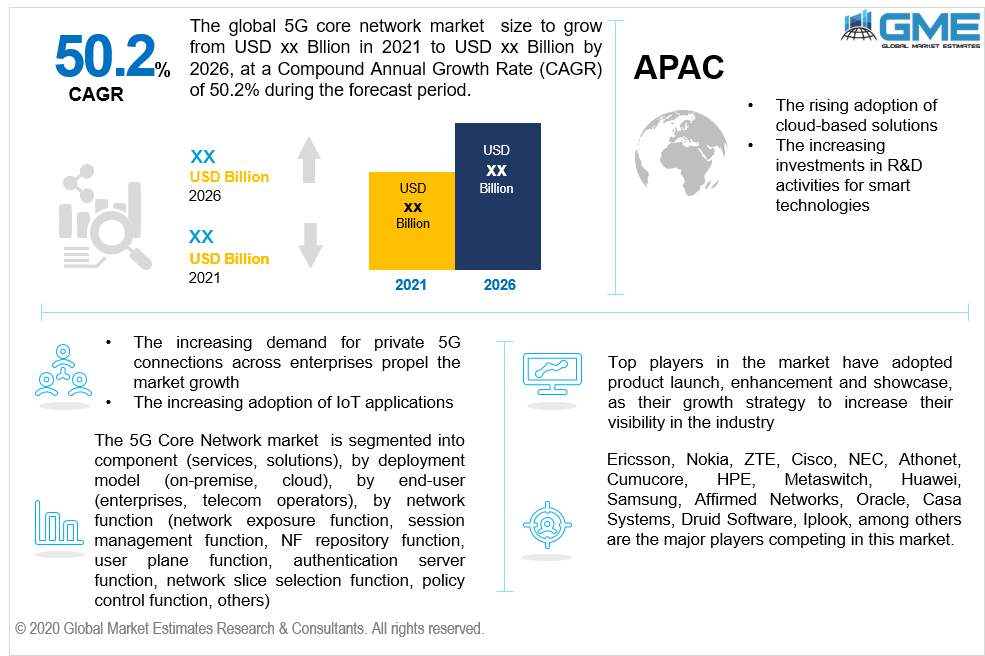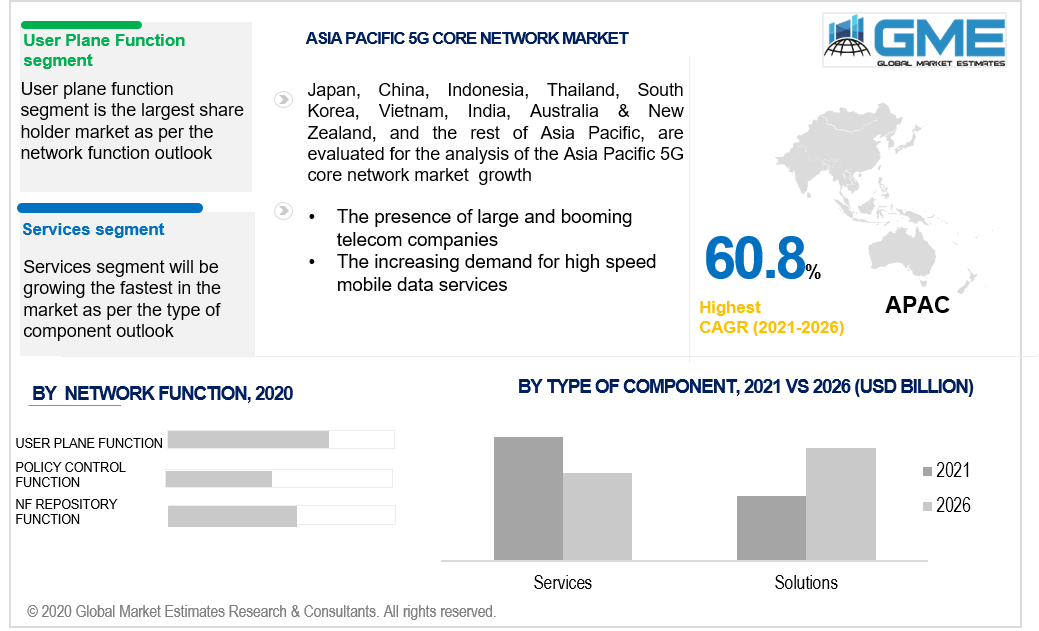
Global 5G Core Network Market Size, Trends, and Analysis- Forecasts To 2026 By Component (Services, Solutions), By Deployment Model (On-Premise, Cloud), By End-User (Enterprises, Telecom Operators), By Network Function (Network Exposure Function, Session Management Function, NF Repository Function, User Plane Function, Authentication Server Function, Network Slice Selection Function, Policy Control Function, Unified Data Management, Access, and Mobility Management Function, Application Function, Others), By Region (North America, Asia Pacific, CSA, Europe, and the Middle East and Africa); End-User Landscape, Company Market Share Analysis & Competitor Analysis
The 5G core network framework is the new 5th generation specification that supports the rising demands for high connectivity speed performance in both developed and developing nations. The 5G core also focuses on NFV as an integral concept design with virtual server’s software functions which can be implemented using the MEC framework that is fundamental to the 5G architectural concepts. Growing technical developments in machine-to-machine communication networks and the adoption of IoT applications are likely to bring new opportunities to the global 5G core network market from 2021 to 2026. Furthermore, the rising demand for private 5G connections across enterprises, industrial sectors, and government clubbed with the increasing adoption of virtual networking architecture in the telecommunication industry will grow exponentially from 2021 to 2026.

Services and solutions are the two types of components of the 5G core network market. The services segment will grow the fastest over the projected timeframe. It is mainly due to the growing demand for high-speed mobile data services.
Enterprises and telecom operators are the market segment based on end-user outlook. The corporate / enterprise segment held the largest market share in 2020. This is due to the increasing demand for high-speed connectivity and high data bandwidth for users located in both urban and rural areas. Such efficient connectivity is most preferred due to its advantages such as uninterrupted video streaming, seamless communication throughout cloud computing, and the development of a smart workplace by offering improved connectivity to IoT devices.
Network exposure function, session management function, NF repository function, user plane function, authentication server function, network slice selection function, policy control function, unified data management, access, and mobility management function, and application function are the key network function segments. The user planes function segment is anticipated to witness significant growth in the market over the forecast timeframe. The User Plane Feature (UPF) is a key component of the 3GPP 5G core infrastructure system architecture.

Over the projected timeline, the North American region is projected to boost the market and have a dominant share. This can be due to the high rate of adoption of emerging technologies like wearable technology and IoT. 5G addresses the secure and fast communication required for these technologies. On the other hand, the Asia-Pacific region will be the fastest-growing region owing to the increasing adoption of cloud-based software, advanced telecommunication technologies, and big data analytics. The APAC region is also recognized as one of the largest markets for connected devices.
Ericsson, Nokia, ZTE, Cisco, NEC, Athonet, Cumucore, HPE, Metaswitch, Huawei, Samsung, Affirmed Networks, Oracle, Casa Systems, Druid Software, Iplook, among others are the key players competing in this market.
Please note: This is not an exhaustive list of companies profiled in the report.
In January 2021, Nokia and Zain KSA have announced to launch Saudi offices and homes with 5G-powered Wi-Fi 6, and FWA
In July 2020, Chunghwa Telecom, a supplier of Ericsson launched its commercial 5G network in Taiwan
We value your investment and offer free customization with every report to fulfil your exact research needs.
The Global 5G Core Network Market has been studied from the year 2019 till 2026. However, the CAGR provided in the report is from the year 2021 to 2026. The research methodology involved three stages: Desk research, Primary research, and Analysis & Output from the entire research process.

The desk research involved a robust background study which meant referring to paid and unpaid databases to understand the market dynamics; mapping contracts from press releases; identifying the key players in the market, studying their product portfolio, competition level, annual reports/SEC filings & investor presentations; and learning the demand and supply side analysis for the 5G Core Network Market.

The primary research activity included telephonic conversations with more than 50 tier 1 industry consultants, distributors, and end-use product manufacturers.

Finally, based on the above thorough research process, an in-depth analysis was carried out considering the following aspects: market attractiveness, current & future market trends, market share analysis, SWOT analysis of the companies and customer analytics.

Tailor made solutions just for you
80% of our clients seek made-to-order reports. How do you want us to tailor yours?
OUR CLIENTS